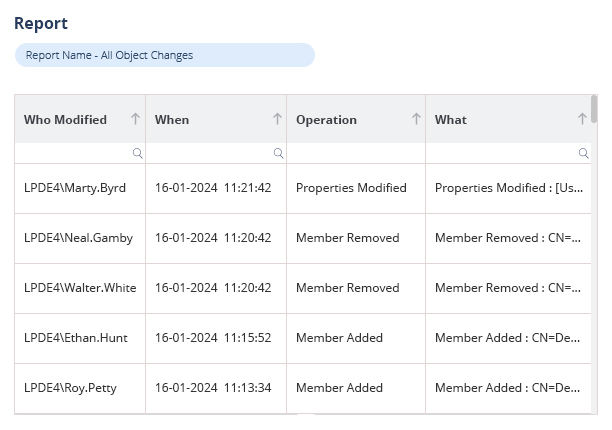
Active Directory’s database has specific rules for naming computer objects, which can clash with the namespace conventions used in Unix/Linux environments. AD Bridge offers a solution to bridge these discrepancies seamlessly. It uses the dNSHostName value of a computer object as the primary identifier in Active Directory, while the computer’s name in AD (sAMAccountName) doesn’t have to match the local host name of the system.
This allows for effective integration between Active Directory and Unix/Linux deployments, resolving naming conflicts and ensuring smooth communication and resource access across different platforms.
What Are Common Naming Limitations in Active Directory?
Below are the most notable naming limitations associated with Active Directory.
1. Computer Names Exceeding The 15-Character Limit
Windows systems (including Active Directory) have a restriction on computer names (sAMAccountName), limiting them to a maximum of 15 characters. However, in UNIX environments, machine names can often exceed this 15-character limit.
To accommodate this difference, AD Bridge offers a solution.
During the computer join process, it generates a new hashed computer name that complies with the Windows naming convention. This hashed name is derived from the original machine name by taking the first seven characters, appending a hyphen, and then adding a unique seven-digit code.
This generated name serves as the computer’s identifier within Active Directory only and is not used in any other context. This mechanism allows AD Bridge to seamlessly integrate UNIX machines with longer machine names into a Windows Active Directory environment.
2. Duplicate Machine Names
When discussing Windows domains, the uniqueness of computer names is paramount. However, when embarking on the migration of UNIX systems to Active Directory (AD) via AD Bridge, a unique challenge arises: the presence of multiple machines sharing the same host name but sporting distinct Fully Qualified Domain Names (FQDNs) within the same AD domain.
To address this conundrum, AD Bridge cleverly generates new and unique hashed computer names during the join process for subsequent conflicting computer names. This generated name, a clever blend of the original name’s first seven characters, a hyphen, and a distinctive seven-digit code, serves as a unique identifier for the object in AD.
Note that this generated name is solely used within AD and does not affect the local machine’s host name or communication with other hosts. To ensure the preservation of each machine’s FQDN, the “–disable hostname” parameter must be employed during the join operation.
3. SPN Uniqueness
Starting with Windows 2012 R2, Microsoft enforced Service Principal Name (SPN) uniqueness across the entire Active Directory forest. This means that computers with different Fully Qualified Domain Names (FQDNs) will encounter problems joining domains with duplicate computer names.
In earlier versions of Windows, two computer objects with the same Security Account Manager (sAMAccountName) could coexist in the same forest.
However, in Windows 2012 R2 and later, joining a computer with the same sAMAccountName as another system in the forest will result in failure. This change was implemented to enhance security and prevent potential naming conflicts and impersonation attacks within the Active Directory environment.
4. Avoid Dynamically Generated Computer Names
In certain environments, it is advantageous to manually control the name of a computer object instead of relying on the dynamically generated, hashed values. This approach, known as pre-staging the computer object, ensures a consistent and predictable naming convention. However, it is still crucial to assign a unique name to each computer.
To pre-stage a computer account and avoid generated/hashed names, follow the standard procedure for pre-staging computer accounts. Use Active Directory Users and Computers, ADSI Edit, or other tools capable of directly modifying AD attributes, and locate and view the properties of the pre-staged computer account.
You will also need to identify and modify the dnsHostName attribute to match the Fully Qualified Domain Name (FQDN) of the computer that will be joined using this computer account. Finally, save all changes to complete the pre-staging process.
How Lepide Change Reporter (Free Tool) Helps?
Lepide Change Reporter (Free Tool) is designed to make Active Directory auditing and monitoring straightforward and actionable. The tool tracks and reports on all changes made to users, groups, group memberships, organizational units, permissions, and other AD objects-helping you quickly identify who made what change, when, and from where. Its intuitive dashboard and consolidated audit reports transform raw event logs into clear, meaningful insights, so you can easily spot potential security risks or unauthorized activities without sifting through overwhelming data.
Beyond just recording changes, Lepide Change Reporter enables real-time monitoring with the help of intuitive radar tab, ensuring you’re immediately aware of modifications or suspicious behavior in your AD environment. This level of visibility is essential for maintaining security, streamlining IT operations, and meeting compliance requirements. By providing precise, actionable audit data, Lepide helps organizations maintain control over their Active Directory and respond quickly to any unwanted or risky changes.

